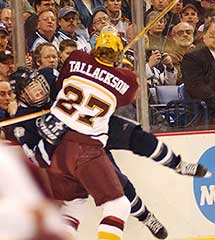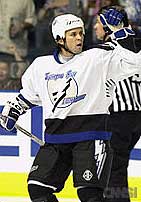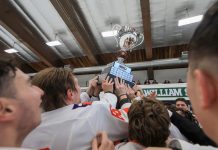Thoughts and observations from the season that just passed.
This was a somewhat tumultuous season on some levels. There were a disturbing number of incidents involving coaches and players, one of which led directly to the firing of Clarkson’s Mark Morris. There were coaches getting reprimanded for berating officials; there were two teams that dropped their program; unruly fan behavior; various sordid other scandals and criticisms of administrators — some by yours truly; and there was the ugly Joe Exter incident, which inflamed all sorts of passions on all sides.
But college hockey manages not to disappoint, especially when we’re focused on what’s going on between the boards.
Some of the highlights:
Cornell/Ivies. Ivy League schools placed in the top 5 of the ECAC. Whether this says something about how far the non-Ivies have fallen or not, who’s to say. But in an era where the rich are getting richer, it’s nice to see the little guy keep up. It also bodes well if the non-Ivies can get their act back together. With the Ivies already flourishing, relatively, if Clarkson, St. Lawrence, Colgate, RPI and Vermont can rebuild, the whole league will benefit. And c’mon, how many of you really ever believed — agree with it or not — that Cornell would ever be ranked No. 1?
Ferris State. Bob Daniels has always been one of the most pleasurable hockey people to talk to, so it was great to see him finally get some reward. Again, another win for the little guy.
The freshmen. What a year for college hockey’s incoming class. Is this because there have been so many early departures of stars in recent years that it gives more room for freshmen to shine? Or are the new breed genuinely great? I think some of it is the former, but I lean much more heavily to the latter. Jeff Tambellini, Thomas Vanek and Zach Parise are superstars. Al Montoya and Jim Howard in goal. And many, many other freshmen had stellar seasons. And let’s not forget the ECAC. Between Matt Moulson, Hugh Jessiman, Shane Hynes and Jamie Sifers, the league did very well in recruiting. And Harvard, Cornell and Dartmouth all have great recruiting classes again. This year’s NHL Draft should be big for college hockey.
16-team tournament. We’ve had more dramatic NCAA tournaments in recent years, but it was tremendous to finally have the 16-team field. It was great as well, on a somewhat related note, to see three newcomers: Ferris State, MSU-Mankato and Wayne State. The only potential concern was the split attendance in the East, and it did hurt a little, but overall, the concept was clearly worth it. Kudos to all who made it happen, and to all the fans, who pay the money that helps convince the “powers that be” that it’s worth supporting.
The Hobey Race. Two stud scorers and a goaltender who broke the all-time NCAA record for lowest goals against average. It was anyone’s guess until the very end.
Massachusetts/Colorado College. Why do we have the funny feeling that UMass’ tremendous road sweep at Maine in the Hockey East playoffs was only the beginning? Because Don Cahoon is in charge, and we’ve seen this before. Unless Jack Parker retires in the next couple of years (you know what I mean), look for big things from UMass. … And a lot of people thought Colorado College would fall back in the pack when Don Lucia left. But, even though this year’s finish was disappointing, isn’t it about time Scott Owens got his due?
Minnesota. What more can you say? Back-to-back national titles, the first time for anyone in 31 years. ‘Nuf said. And even though Minnesota is known as the Evil Empire to many, it’s pretty hard to root against players like Jordan Leopold, Paul Martin, Grant Potulny and Thomas Vanek.
The disappointments. There’s always a couple. Off the ice, it was clearly the Mark Morris situation. Whichever way you fall on it, it’s bad for Clarkson and bad for the ECAC, which doesn’t need such things hindering one of its signature programs. … On the ice, no one is sure what happened to Denver, everyone’s preseason No. 1. Alaska-Anchorage fell off the charts after a promising 2001-02, going winless in 35 games, believed to be a modern record. … Patience is running thin at Notre Dame and Northeastern as well.
More Pride On Ice
I guess we’re pretty much stating the obvious at this point, but let’s give a hand to Don Lucia for the remarkable job he’s done with the Gophers.

Not, of course, being inside the locker room, and not being an expert on Xs and Os, Lucia nevertheless strikes me as an honest, accessible, intelligent and hard-working guy. And clearly his philosophy, personality and coaching ability have been a winning mix in Minneapolis. He seems like someone who would be great to play for, yet he can be tough when need be.
This ability to be tough, yet relate to his players, has come in particularly handy with the Gophers, who were by all accounts enjoying a country-club atmosphere when he arrived. And this year, when most people wrote off the Gophers before the season even started, he took a talented, yet very young, team and gave them a kick in pants.
Minnesota is never going to be known as a physical team, but they have learned to be tough, and credit for that goes to Lucia.
Now if we can just stop the rioting in Dinkytown, we’ll be all set. (Does this really require further exposition, or is the ignorance and sheer stupidity of it all self-evident?)
Rule Check
Early in the season, there was a fight during a game between Yale and North Dakota. Four players from each team were given game disqualifications for fighting. Afterward, the tape clearly showed that at least four of the combatants (two from each team) never dropped the gloves, and barely scuffled.
Representatives from the WCHA and ECAC, on behalf of the two teams, questioned the decision, but ultimately found it clearly stated in the rule book: discipline handed out by game officials cannot be reversed. Supplementary discipline can be handed out after the fact that adds to the on-ice penalties, but decisions of game officials cannot be reversed or reduced.
I understand the impetus for such a rule. It probably was intended to avoid situations where there is constant appealing to the league office over officials’ decisions.
But in a case where there is such clear-cut evidence of an injustice, doesn’t it demand a mechanism for reversing that call? Especially in college hockey, when each game means so much.
Equal Time
There were a couple of instances this year where coaches were reprimanded for making detrimental comments about referees in the media.
When this occurs, you invariably hear fans yell something like, “Hey, this is America, he can say whatever he wants.” Which is a ludicrous argument on oh so many levels. Hockey East isn’t sending the coaches to jail.
Making a little more sense is: “What’s wrong with criticizing the officials? Sometimes criticism makes you better. Are they so thin-skinned?”
Somewhat more logical. The problem is, it is crucial for leagues of all sorts to prevent coaches and players from openly criticizing officials. For one, it’s just unseemly. Second, it’s a one-way street. It’s not like referees can sit there and criticize coaches’ decisions. I could just see that:
“Hey ref, whadya think of the game?”
“Well, New Hampshire came at them like gangbusters, and I don’t know what Parker was thinking with those line combos. And picking that knucklehead to take the faceoff, what was he thinking?”
Don’t Look Back
When Fairfield and Iona decided to drop their hockey programs, it wasn’t just the MAAC that lost two teams — all of college hockey lost them. It lowered to 58 the number of Division I men’s varsity teams. On the surface, despite all this optimism over the growth of hockey, it seemed to signal a disturbingly negative trend.

But I would not fret whatsoever. Basically, those were schools originally playing Division III schedules, forced to play in Division I because of changes in NCAA rules. The MAAC was born out of those shadows, with a tricky alliance of schools just happy to be there, and others that were trying to make serious inroads into Division I (Quinnipiac, Canisius, Connecticut, etc…). That’s why the league was restricted to 11 scholarships, and some schools don’t even give that.
The loss of Iona and Fairfield will be a long-term positive for the MAAC, which can now turn its attention toward serious growth — Navy, Robert Morris and Rhode Island.
By the same token, it’s not just the ECAC which could conceivably form a hockey-only conference. Don’t be surprised if that ever happens to the MAAC schools, especially considering only one full-sport MAAC member now exists in the hockey conference — Canisius.
Fast Forward
Am I the only one who doesn’t like the 15-second faceoff rule?
I don’t hate it, I’m just not sure it was necessary for college.
The NHL went to this after seeing the effect in the Olympics. Mainly, this was done to speed up games, and on that score, it worked like a charm.
But in college hockey, most games are not televised, and most, therefore, already ended in about 2:25. Now they end somewhere between 2:00 and 2:10. I guess it’s good when I have a 5-hour drive home, but … I don’t know, I don’t always want my night to end that quickly, eh? Not to mention, I saw some games where it looked more like an 8-second faceoff rule — not even enough for two bars of Gary Glitter.
It also takes away some of the line-matching abilities of the coaches. If you have a game with no TV timeouts, it’s harder for the home team coach to really utilize his last change powers.
Of course, who’s to say that really mattered. Here’s the home team winning percentage the last few years (Is this really relevant? Who knows, but hey, it’s for laughs):
2002-2003 .594 (558-365-107)
2001-2002 .608 (568-349-96)
2000-2001 .595 (507-329-99)
1999-2000 .562 (389-296-71)
1998-1999 .559 (391-300-81)
What does it mean? Absolutely nothing in relation to this discussion. Although, if you’re wondering, the higher home winning percentages in recent years can simply be explained by more MAAC and CHA schools playing a lot of road games against “Big 4” opponents.
Tech-no
Michigan Tech is winding down its process of finding a new coach, something it’s had trouble doing ever since John MacInnes retired.
Mike Sertich did a good job of restoring some dignity to the program, which took a hit under the overwhelmed Tim Watters. But he left sooner than anyone had expected. In fact, that caused some behind the scenes tension.
According to a source close to the situation, when Sertich came in, he stipulated that, when he left, assistant Mark Maroste would be awarded the job. Tech athletic director Rick Yeo agreed. However, Sertich left much sooner than Yeo expected, and Yeo was not convinced Maroste was ready.
Maroste is being interviewed for the vacancy, but his hiring is far from certain. Other candidates are Cornell assistant Jamie Russell and Northern Michigan assistant Dave Shyiak.
Russell, a Tech alum, is the Big Red’s main recruiter and runs the defense during games. It’s hard to argue with those results, since Cornell had the top defense in the nation, and one of its top recruiting classes the last two seasons — especially given Cornell’s recruiting restrictions.
Size Doesn’t Matter
My favorite NHL players are Martin St. Louis and Todd White. Needless to say, I’m enjoying the NHL playoffs.
Even though White knocked off my Islanders, including a game-winning OT goal, I’ll forgive him. The former Clarkson star has become a major top-line contributor for Ottawa, the league’s top team — just like when he was with the Golden Knights.
St. Louis, meanwhile, has five goals for Tampa Bay, including the Game 6 OT winner that sent the Lightning to Round 2.

St. Louis is my favorite player for a lot of reasons. First of all, there was no more enjoyable player to watch in my 15 years of covering college hockey than him. His four years at Vermont coincided with my four years broadcasting at Princeton, and even though the Tigers lost the first seven meetings against him, he — and linemate/soulmate Eric Perrin — were a treat to watch (despite his occasional bouts of showboating, something he has given up, thankfully).
It’s hard to separate St. Louis and Perrin, their lives and careers were so intricately entwined, from pee-wee hockey through their first pro year with Cleveland of the IHL. But then St. Louis got a contract with Calgary, and tore up the AHL for a couple of years with their top farm team in Saint John. But Calgary never gave St. Louis a fair shake.
Luckily for St. Louis — and for the Lightning — Tampa Bay has.
Which brings me to the other reason for liking him so much … sheer pride. League pride, as an ECAC fan, and personal pride, as one of the people who just knew that, given a fair shake, he would be an outstanding NHL player. When a guy is that talented, I don’t care how small he is. And when you watched him as often as I did in college, you could see his heart. Frankly, that’s the main thing that separated him from Perrin — and St. Louis’ lateral skating ability — because otherwise, St. Louis and Perrin were inseparable off the ice, and all but indistinguishable on the ice, both in statistics and accolades.
But St. Louis has been proving people wrong for a long time — even when he was tearing things up in college.
Ergo, my favorite Martin St. Louis story (stop me if you’ve heard this one before):
St. Louis and Perrin just got finished tearing up the ECAC in 1995-96, and were headed to the NCAAs. All you heard from the Westerners at that time was, there’s no way this guy could really be that good. It was doubt of St. Louis and Perrin themselves, and of course the usual doubt in the ECACs.
So, Lake Superior beats Cornell, 6-5, in the first round of the NCAAs in Albany (I can’t believe I just reminded myself of that painful memory — P.C. Drouin, crossbar, DING, ahhhhhh!). Vermont had the bye, and faced Lake Superior — in Jeff Jackson’s last season as coach — for the right to go the Frozen Four.
With a still skeptical eye being cast towards the dynamic duo, Perrin wins the opening faceoff, and gets it to St. Louis. St. Louis proceeds to make a move over the blue line, cuts to the middle, does a drop pass between his legs to himself, reaches back with his leg and shuffles the puck behind himself and across to his stick, and unloads a rocket of a slap shot that missed the crossbar by about a foot.
It was a jaw-dropping move … at least for those in attendance not used to seeing such things on a regular basis. I just said, “That’s my boy.”
Vermont won, 2-1, as Eric Perrin stopped a shot rolling through the crease with about a minute left, and then Vermont lost in double OT to Colorado College in the NCAA semifinals, in the quagmire in Cincinnati (where they were robbed, but I digress).
See ‘ya
Last year at this time, we had the 16-team tournament to look forward to. Nothing as dramatic is on the horizon for next year, but knowing college hockey, something will happen that we’ll never forget.
We’ll see you at the rinks next year, and until then, stay tuned to USCHO … because the news doesn’t stop just because the season does.


